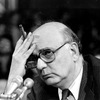Federal Reserve Chairman Jerome Powell attends a meeting at the Spain’s Central Bank in Madrid, Spain, Thursday, June 29, 2023. In the U.S., Powell and the central bank are trying to navigate a “soft landing” for the economy.
Manu Fernandez/AP
hide caption
toggle caption
Manu Fernandez/AP


Federal Reserve Chairman Jerome Powell attends a meeting at the Spain’s Central Bank in Madrid, Spain, Thursday, June 29, 2023. In the U.S., Powell and the central bank are trying to navigate a “soft landing” for the economy.
Manu Fernandez/AP
Pack up the umbrella and the beach towel and head back to the car: The Fed’s Hot Pause Summer is officially over.
The Federal Reserve announced on Wednesday it would raise interest rates a quarter percentage point (or 25 basis points), to a 22-year high. It marks a return to the long, steady climb interest rates have been on for the last year, as the Fed attempts to beat back inflation.
“The Committee remains highly attentive to inflation risks,” the Fed said in a press release.
Last month, Federal Reserve chair Jerome Powell hit the pause button on those rate hikes, which was like an economic beach holiday for consumers and Wall Street.
It meant credit card interest rates wouldn’t keep rising and that loans people and businesses wanted to take out for things like houses weren’t getting more expensive by the day.
And, even with the interest rate steady, inflation continued to fall, to roughly 3% (very near the Fed’s goal rate of 2%) and the unemployment rate remained near historic lows.
Why is the Fed back to raising rates?
After nearly a year of aggressive action and rates at decades-long highs, why not keep the pause in place?
“I think the message they wanted to send is that things are moving in the right direction, but we need to wait and see,” says economist Raghuram Rajan, former head of India’s Central Bank and professor at The University of Chicago’s Booth School of Business.
“Rather than, ‘We’re done,’ they’re waiting to see how the economy reacts and then deciding how much more medicine it needs,” he says.
In a press release, the Fed wrote: “Job gains have been robust in recent months, and the unemployment rate has remained low. Inflation remains elevated.”
The Fed is trying to strike a tricky balance right now, Rajan says, what economists often call a “soft landing”: Raising interest rates just enough to slow the economy down to where inflation falls, but not so much that the economy ends up in a recession.
The Fed’s tricky balance
When interest rates rise, people and businesses have to pay more on their loans. They then borrow — and spend and buy — less. Companies sell less stuff because there are fewer buyers, and that usually brings prices down. And, voila: Inflation comes down.
The trouble is, when companies make less money, they also don’t expand, and will often lay people off. Those things can cause a recession.
Now that things are moving in the right direction, says Rajan, the Fed probably doesn’t want to take its foot off the brake and risk inflation getting out of control.
Then the U.S. will be caught in the dreaded inflationary spiral, when prices rise out of control, and our savings and paychecks are worth less by the day.
The cautionary tale
An inflationary spiral took hold of the U.S. economy back in the 1970s and the Fed had to take aggressive action that caused a deep recession and high unemployment for years.
Right now, in spite of everything looking good, it’s important for the Fed to be cautious, says economist Matthew Slaughter, Dean of Dartmouth’s Tuck School of Business.
“I’ve always been Team Soft Landing, aspirationally,” he says. “But the empirical economist in me thinks that’s pretty unlikely.”
Slaughter points out that historically, when countries try to get back to a low target inflation rate, it almost always causes a recession.
The economy on ice
Slaughter says big economic actions, like raising interest rates, can take time to play out. He compares monetary policy to the sport of curling, which was popular in Minnesota, where he grew up:
“You’ve got the puck… and you push it and the team can try and direct it and brush the ice… but in the end, they just have to wait and watch it move down the ice,” he says.
The Fed stressed this, saying: “The Committee is strongly committed to returning inflation to its 2% objective.”
Slaughter expects more interest rate hikes this year, but says we could see more pauses as well, as the Federal Reserve watches to see where the economy moves in coming months.
This story originally appeared on NPR




